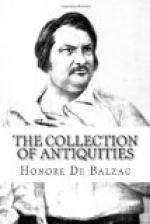“Mlle. d’Esgrignon was one of my religions. To this day I can never climb the staircase of some old manor-house but my foolish imagination must needs picture Mlle. Armande standing there, like the spirit of feudalism. I can never read old chronicles but she appears before my eyes in the shape of some famous woman of old times; she is Agnes Sorel, Marie Touchet, Gabrielle; and I lend her all the love that was lost in her heart, all the love that she never expressed. The angel shape seen in glimpses through the haze of childish fancies visits me now sometimes across the mists of dreams.”
Keep this portrait in mind; it is a faithful picture and sketch of character. Mlle. d’Esgrignon is one of the most instructive figures in this story; she affords an example of the mischief that may be done by the purest goodness for lack of intelligence.
Two-thirds of the emigres returned to France during 1804 and 1805, and almost every exile from the Marquis d’Esgrignon’s province came back to the land of his fathers. There were certainly defections. Men of good birth entered the service of Napoleon, and went into the army or held places at the Imperial court, and others made alliances with the upstart families. All those who cast in their lots with the Empire retrieved their fortunes and recovered their estates, thanks to the Emperor’s munificence; and these for the most part went to Paris and stayed there. But some eight or nine families still remained true to the proscribed noblesse and loyal to the fallen monarchy. The La Roche-Guyons, Nouastres, Verneuils, Casterans, Troisvilles, and the rest were some of them rich, some of them poor; but money, more or less, scarcely counted for anything among them. They took an antiquarian view of themselves; for them the age and preservation of the pedigree was the one all-important matter; precisely as, for an amateur, the weight of metal in a coin is a small matter in comparison with clean lettering, a flawless stamp, and high antiquity. Of these families, the Marquis d’Esgrignon was the acknowledged head. His house became their cenacle. There His Majesty, Emperor and King, was never anything but “M. de Bonaparte”; there “the King” meant Louis XVIII., then at Mittau; there the Department was still the Province, and the prefecture the intendance.
The Marquis was honored among them for his admirable behavior, his loyalty as a noble, his undaunted courage; even as he was respected throughout the town for his misfortunes, his fortitude, his steadfast adherence to his political convictions. The man so admirable in adversity was invested with all the majesty of ruined greatness. His chivalrous fair-mindedness was so well known, that litigants many a time had referred their disputes to him for arbitration. All gently bred Imperalists and the authorities themselves showed as much indulgence for his prejudices as respect for his personal character; but there was another




